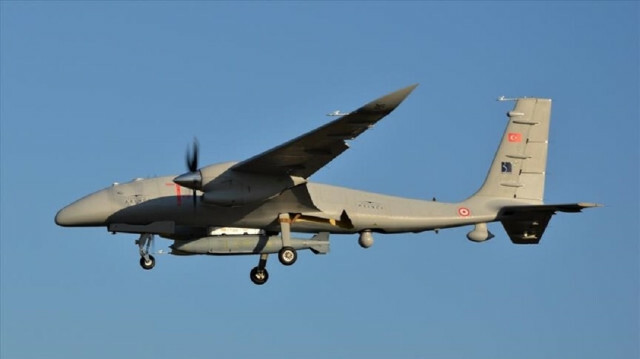
One should not forget that the underlying success in the Karabakh, Syria, and Libya frontiers were not merely Turkish drones, but Turkish way of drone warfare. It remains to be seen which concepts and way of warfighting the Akinci stands to inspire
Recently, the Turkish Armed Forces have started receiving the first batch of its new Akinci unmanned aerial systems (UAS). Designed and produced by Baykar, namely the makers of the ‘Pantsir-hunter’ Bayraktar TB-2, the Akinci drone comes with heavy fire-power and flexible concepts of operations (CONOPS). More importantly, along with other key achievements, such as TUSAS’ Aksungur drone [1] with anti-submarine warfare capabilities, STM’s Kargu [2] and Alpagu kamikaze drone baselines with high artificial intelligence features and advanced algorithms, Meteksan and Ares Shipyard-made ULAQ [3] unmanned naval surface combat system, as well as newly introduced [4] unmanned land warfare system prototypes, Turkey’s defense technological amp; industrial base has developed an exponentially growing know-how on robotic warfare solutions.
- Heavily-armed and dangerous: The Akinci’s combat payload is noteworthy
Baykar’s Bayraktar TB-2 played chief roles in Azerbaijan’s military victory in the Second Karabakh War following Turkey’s Syria and Libya expeditions. Being a much bigger beast than the Bayraktar TB-2, the Akinci’s large combat payload capacity of 1,350 tons will bring more lethal weaponry and flexible CONOPS.
The Akinci has already carried Roketsan's MAM-T munitions during live-fire test flights. To begin with, the main weapon of choice for Turkish and Azerbaijani military operations was a smaller one, the MAM-L [5], which weighs some 22 kg and has a range of 8 to 14km. The MAM-T, the new and heavier variant, weighs over 90kg, bringing a more destructive firepower. The Akinci is also able to carry Turkey’s TUBITAK-SAGE joint direct attack munitions, namely, once dumb-bombs modernized with guidance kits.
Amongst the Akinci’s combat payload [6] configurations, without a doubt, SOM-A indigenous air-launched cruise missile deserves the utmost attention. With a range of about 250 kilometers, the SOM-A amp; Akinci combination will provide Turkish military planners with deep strike capabilities from unmanned platforms. In hostile airspaces, such as Syria to begin with, such a capacity can yield decisive strategic results, especially against high-value target sets.
Finally, the IDEF-2021 exhibition suggests another interesting heavy munitions integration, which appears to be the TRG-230 heavy-rocket / tactical ballistic missile modification for Turkey’s new generation drones with large payloads. Originally designed for land warfare, the TRG-230 weighs some 210 kg and comes with a 50-kg warhead, allowing for an effective radius of more than 55 meters. Furthermore, the munitions’ guidance systems (GPS amp; INS) make it an accurate asset with less than 10 meters of CEP (circular error probable). In simpler terms, a single TRG-230 can effectively unleash so much destructive power that fills a soccer field with reliable precision.
- Innovative CONOPS and capabilities ahead
As to the CONOPS dimension, Turkey’s Akinci can spark some futuristic thinking. Naturally, we have little open-source evidence that can shed light on the Turkish defense technological and industrial base’s plans. There are, however, some clues. On May 26, 2019, for example, Turkey’s procurement chief, Prof. Ismail Demir, posted an ambitious simulation on his Twitter feed, [7] showcasing indigenous Alpagu kamikaze drones released by the Akinci UAS, using the latter as a mother-ship for swarming strikes delivery. The STM’s Alpagu line [8] –along with its rotary-wing sister Kargu– enjoys smart algorithms and other autonomous features as well as advanced image-processing systems. The Akinci can also share real-time target updates with the released kamikaze drones relying on its advanced sensors, including an AESA radar. Such a CONOPS preference can herald the beginning of a true Lethal Autonomous Weapons Systems era for Turkey.
Another important issue remains the systematic integration between electronic warfare (EW) systems and drone warfare assets. Simply put, back in Operation Spring Shield 2020, Turkish unmanned aerial systems operated within the engagement envelopes of the Syrian Pantsir air defense systems equipped with 57E6 missiles and 30-mm 2A38M anti-aircraft artillery, offering a 20-km range and a 15-km altitude, and a 4-km range and a 3-km altitude coverage respectively in baseline configurations [9] (Modernized variants [10] of the Pantsir family can be effective even between 30- and 40-kilometer range). An efficient cooperation between the Turkish EW weaponry and drones made it possible to destroy the Pantsirs, along with other air defenses, within their engagement envelopes.
At present, Turkey’s defense industries are making a rapid progress in the EW segment. Thus, it remains to be seen what a marriage between the Akinci and the Turkish military’s capabilities in the electro-magnetic spectrum will bring in the future.
Apart from conventional military gains, Akinci can bring additional horizons to the wider Turkish security sector. Turkey’s national intelligence service, for example, has long been a user of drone warfare capabilities. Targeted drone strikes eliminating the PKK amp; YPG terror network in northern Iraq and Syria have gradually become a key pillar of Turkey’s counterterrorism policy. With the Akinci’s longer-range, smart, and heavier payload capability, the Turkish intelligence’s targeted drone strikes can graduate to a whole new level.
Finally, much has been speculated as to the Akinci’s aerial warfare capabilities. The UAS’ combat payload configuration includes Turkey’s indigenous within-visual-range and beyond-visual-range air-to-air missiles Bozdogan and Gokdogan. So, can the Akinci score real aerial warfare kills? So far, we do not have any records of unmanned platforms intercepting manned aircraft. In 2002, a US Predator drone tried to down an Iraqi Mig-25. [11] Even the Mig-25, dating back to the late 1960s Soviet technology, was almost a mission impossible for the Predator as the Iraqi aircraft had significant speed and kinematic advantages. We have some unmanned-on-unmanned kill records [12] though. During military drills in 2018, a US MQ-9 Reaper UAV shot down a target drone.
All in all, one should not expect the Akinci to engage in dogfights or shoot down enemy fighter jets. Most probably, it is never going to happen. However, in a hypothetic, more favorable scenario in which the Akinci is well-supported by an efficient network of friendly sensors and radars, and fires its beyond-visual-range air-to-air missiles against, say, a slow-flying light attack aircraft or a rotary-wing platform with little situational awareness and no topographical advantage offered by the operating environment, then the world can witness the very first unmanned-on-manned kill of the air warfare history. But still, to be clear, the Akinci is a high-end strategic drone, not an air warfare asset.
Last but not least, the Akinci is not only a giant weapons-carrier. It comes with an AESA radar and other advanced signals amp; electronic intelligence capabilities, along with a set of powerful AI features. The drone also operates at altitudes ranging between 30,000 and 40,000 feet. Thus, in a network-centric warfare setting, it can provide robust intelligence-surveillance-target acquisition-reconnaissance (ISTAR) to other friendly units, particularly to land-based fire-support formations.
- What next?
In Turkish military history lexicon, the term ‘Akıncı’ (Akinji / the raider) refers to the highly warfighting-capable and swift light cavalry formations executing special tasks such as hit-runs behind enemy lines, reconnaissance in hostile territory, and pioneering advancing armies. Mobile warfighter Akinji units, which can be traced back to the military tradition of Asiatic Turkic hordes’ horsemen warriors of the steppes, were indispensable during the Ottoman imperial conquest campaigns.
Although it is named after the Akinjis, the Akinci drone is not light cavalry from a military standpoint. Rather, combining shock assault weaponry, mobility, and its potential for versatile use, the UAS resembles the heavy cavalry formations of the Turco-Mongol hordes.
One should not forget the fact that the underlying success in the Karabakh, Syria, and Libya frontiers were not merely Turkish drones, but Turkish way of drone warfare. It remains to be seen which concepts and way of warfighting the Akinci stands to inspire.
By Dr. Can Kasapoglu
- The writer is the director of the Security and Defense Research Program at the Istanbul-based think-tank EDAM. Dr. Kasapoglu is also a non-resident fellow on Eurasian Military Affairs at the Jamestown Foundation.
* Opinions expressed in this article are the author’s own and do not necessarily reflect the editorial policy of Anadolu Agency.
Hello, the comments you share on our site are a valuable resource for other users. Please respect other users and different opinions. Do not use rude, offensive, derogatory, or discriminatory language.
The floor is all yours.








